Question development history for 2018
Census: Sexual Orientation
Overview
Summary
Key driver for question development
New Content
Data users have indicated that a
question on sexual orientation needs to
be able to identify specific population
groups within the wider LGBTIQ
population. This is in order to firstly
identify the size of these population
groups within New Zealand and
secondly meet the health and service
provisioning needs for these specific
population groups for relevant
organisations.
Quality priority level:
3
Outcome from question development <maybe
Cognitive testing
we update this section in 2017>
Usability testing
Mass completions
Volume test
1 – Purpose
The purpose of this document is to capture the question development process for the Sexual
orientation variable, including findings from waves of testing conducted in 2015-2017.
The 2018 variable specification provided by the Customer Needs and Data (content) Team provides
the background and scope of this variable.
This document is intended for use within Statistics New Zealand.
2 – Background
The information sought from this variable is to collect data on aspects of respondent’s self-reported
sexual identity, from the census usually resident population count aged 15 Years and over (ie New
Zealand Adults). This is in order to meet the needs of data users for information on sexual minorities
in New Zealand.
The information need for this variable is to identify the prevalence (number) of individuals who
identify as non-heterosexual within the New Zealand population. This includes lesbian, gay, bisexual,
and other non-heterosexual sexual identities.
Data users have indicated that a question on sexual orientation needs to be able to identify specific
population groups within the wider LGBTIQ population (ie. gay, bisexual etc.) by itself or in
combination with other census variables (most notably sex and any potential gender identity
question). This is in order to firstly identify the size of these population groups within New Zealand
and secondly meet the health and service provisioning needs for these specific population groups for
relevant organisations (ie. health service providers involved in STI and HIV prevention). There is a
strong desire for baseline population counts of the lesbian, gay and other sexual minorities in order
for decisions affecting these population groups to have a strong evidence base than is currently
available.
Currently there is no official definition of sexual orientation for use within statistical surveys in New
Zealand. If data on sexual orientation/identity is to be collected in the 2018 Census, a definition for
sexual orientation/identity will need to be developed.
Previous work undertaken for the OSS has given some background to developing an official
definition of sexual orientation for statistical surveys in New Zealand:
Definitions of sexual orientation (from Pega, F., Gray, A., & Veale, J. (2010) p.56)
Given that the umbrella concept of sexual orientation is defined by three key measurement
concepts, we propose that sexual orientation should be treated as a statistical topic, with three
measurement concepts: sexual attraction, sexual behaviour, and sexual identity. The following
working definitions for the statistical topic of sexual orientation and the associated measurement
concepts are proposed:
Statistical Topic
Proposed Working Definition
Sexual Orientation
Sexual orientation is defined by three key
concepts: sexual attraction, sexual
behaviour, and sexual identity. The
relationship between these components is
that sexual orientation is based upon
sexual attraction and that sexual attraction
can result in various sexual behaviours and
the adoption of sexual identities. The
three key concepts are related, but not
necessarily congruent continuous
variables, each of which can independently
change over time and by social context.
Measurement Concept
Proposed Working Definition
Sexual Attraction
“Attraction towards one sex or the desire
to have sexual relationships or to be in a
primary loving, sexual relationship with
one or both sexes”
(Savin-Williams, 2006, p. 41).
Sexual Behaviour
“Any mutually voluntary activity with
another person that involves genital
contact and sexual excitement or arousal,
that is feeling really turned on, even if
intercourse or orgasm did not occur”
(Laumann, Gagnon, Michael, & Michaels,
1994, p. 67).
Sexual Identity
“Personally selected, socially and
historically bound labels attached to the
perceptions and meanings individuals have
about their sexuality”
(Savin-Williams, 2006, p. 41).
Early scoping work on a development of a Sexual Orientation statistical standard for the OSS has
indicated that sexual identity is the concept that would be most relevant and suitable for general
purposes.
This drew on
work done by the ONS which used the following definition and rationale:
What is sexual identity?
Self-perceived sexual identity is a subjective view of oneself. Essentially, it is about what a person is,
not what they do. It is about the inner sense of self, and perhaps sharing a collective social identity
with a group of other people. The question on sexual identity is asked as an opinion question, it is up
to respondents to decide how they define themselves in relation to the four response categories
available. It is important to recognise that the question is not specifically about sexual behaviour or
attraction, although these aspects might relate to the formation of identity. A person can have a
sexual identity while not being sexually active. Furthermore, reported sexual identity may change
over time or in different contexts (for example, at home versus in the workplace).
Why measure sexual identity rather than sexual orientation?
No single question would capture the full complexity of sexual orientation. A suite of questions
would be necessary to collect data on the different dimensions of sexual orientation, including
attraction, behaviour and identity, and to examine consistency between them at the individual level.
Although legislation refers to sexual orientation, research during question development deemed
sexual identity the most relevant dimension of sexual orientation to investigate given its relation to
experiences of disadvantage and discrimination. Testing showed that respondents were not in
favour of asking about sexual behaviour in a social survey context, nor would it be appropriate in
general purpose government surveys.
2.2 Where this data comes from
This information would be collected on the individual form in a new question. Its placement is likely
to be later in the form (separate from the sex question and next to any potential gender identity
question) and in the sections for those aged 15 or older.
Discussion of potential question formats informed by those used by other collections is below:
Definitions of sexual orientation (from Pega, F., Gray, A., & Veale, J. (2010) p.56) recommended a
question of the following format for use in the OSS (in personal interviews)
ASK ALL AGED 16 OR OVER
Which of the options on this card best
describes how you think of yourself?
Please just read out the letter next to the
description.
(letter) Heterosexual or Straight
(letter) Gay or Lesbian
(letter) Bisexual
(letter) Takatāpui
(letter) Fa’afafine
(letter) Other
(Spontaneous DK/Refusal)
Sexual Identity has also been used as a concept and collected in the New Zealand Health Survey
from 2014/15 (in interviews)
in their sexual and reproductive health module (pg 70). The following
question was asked:
Which of the following options best describes how you think of yourself?
1. Heterosexual or straight
2. Gay or lesbian
3. Bisexual
4. Other
.K Don’t know
.R Choose not to answer
Research done in the USA for the purpose of collecting sexual orientation and gender identity data
for electronic health records and in healthcare settings has also recommended a similar format
which was indicated as a format which would produce necessary data by the NZ Aids Foundation in
their submission.
Sexual orientation
Do you think of yourself as:
_ Lesbian, gay, or homosexual
_ Straight or heterosexual
_ Bisexual
_ Something else, please describe: ___________
_ Don’t know
The content team has recommended that initial testing of collection of sexual identity data follow
the format of the questions recommended by the ONS used in the New Zealand Health Survey.
Which of the following options best describes how you think of yourself?
1. Heterosexual or straight
2. Gay or lesbian
3. Bisexual
4. Other
.K Don’t know
.R Choose not to answer
This has been chosen instead of the recommendation from the previous research by Pega, Gray and
Veale in New Zealand which included tick boxes for Takatāpui
and Fa’afafine for a number of reasons.
- The terms Takatāpui and Fa’afafine indicate a spectrum of identity which is broader than sexual
identity and cross into other aspects of identity including gender identity.
- The question proposed by the previous New Zealand research was intended for personal
interviews. If a question on sexual identity is included in the census, a question format that uses less
space is ideal given the constraints of the paper questionnaire form.
- The New Zealand Health Survey team indicated that cognitive testing for their sexual and
reproductive health module indicated that many people were not familiar with the terms of
Takatāpui and Fa’afafine or interpreted them in different ways.
- The question format being tested will still allow for collection of individuals who wish to self-
identify this way in the sexual identity question through the ‘other’ write in box.
3 – Design differences between paper and internet forms
n/a
4 – Findings from testing (or review) and rationale for revision
These tables summarise in chronological order the versions of this question set that were tested (or
reviewed), along with brief findings, and rationale for revision.
Reasons for variables being omitted from a sprint may include: the content need or question design
is not ready, or the variable is not a focus for that sprint (eg it is not suited to the target
respondents), or the sprint is not a test of content.
Summary of sprints this variable has been tested in, plus testing type and mode type:
Sprint 4; cognitive testing and mass completions of paper forms
Sprint 5; cognitive testing and mass completions of paper forms
Census programme test, July 2016
Sprint 7; cognitive testing and mass completions of paper forms
Sprint 8; cognitive testing and mass completions of paper forms
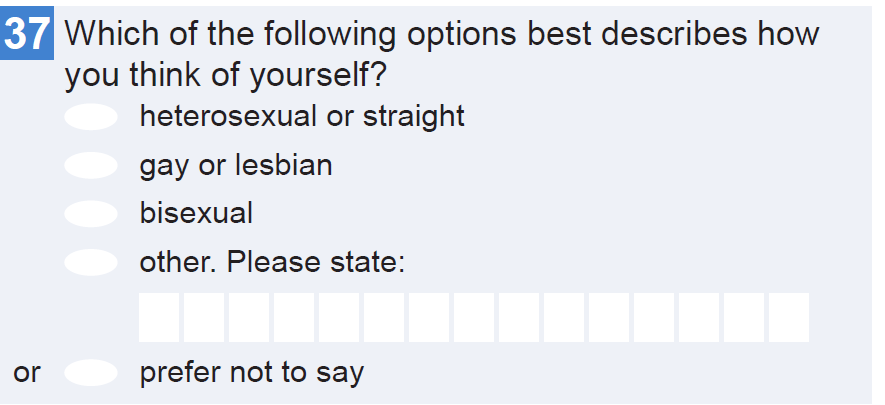
Sprint 9A; cognitive testing and mass completions of paper forms
SPRINT 4; COGNITIVE TESTING AND MASS COMPLETIONS OF PAPER FORMS
March 2016
Christchurch and Wellington
Aim:
The primary objective of the testing is to provide recommendations to inform a Go/No Go
decision on future development and testing of proposed 2018 Census content.
Test question with targeted sections of the general public to assess understanding/potential
for confusion/potential for drop off/potential for offence.
Respondents The cognitive test participants included members of the public, students, and people with step
family. The mass completion test participants included rural fire fighters, secondary students, and
tertiary students (including young parents’ college and ESOL students).
The question design tested in sprint 4 was:
SPRINT 4, COGNITIVE TESTING AND MASS COMPLETIONS OF PAPER FORMS – FINDINGS
English as second language and didn’t understand “heterosexual”
Male respondent happy with term “heterosexual” but thought term straight was a bit
prejudiced
Weird that you could select “prefer not to say” for this but not for gender question
Some uncomfortableness (surprise at inclusion), and giggling at the question
“Oh wow!, really?”
a-sexual option suggested, considered to be as prevalent as bisexual
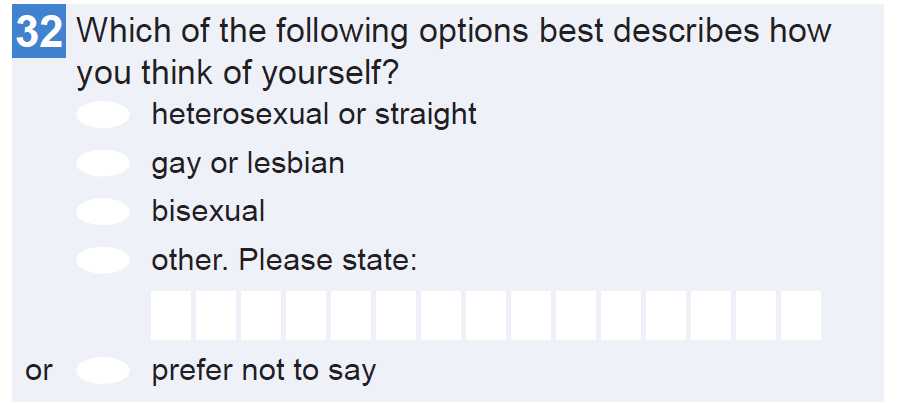 SPRINT 5, COGNITIVE TESTING AND MASS COMPLETIONS OF PAPER FORMS
SPRINT 5, COGNITIVE TESTING AND MASS COMPLETIONS OF PAPER FORMS
March 2016
Wellington and Christchurch
Aim: General Public
The primary objective of the testing is to provide recommendations to inform a Go/No Go
decision on future development and testing of proposed 2018 Census content.
Targeted LGBTQI testing
Test question with targeted sections of the general public to assess
understanding/potential for confusion/potential for drop off/potential for offence.
Test with gay/lesbian/bisexual respondents to assess functioning of question in the New
Zealand context, and as a paper self-complete.
Respondents As with the previous sprint, cognitive test participants included members of the public, students,
and people with step family. The mass completion test participants included secondary and
tertiary students, Age Concern, retirement village residents, and a private workplace.
The question design tested in sprint 5 was:
SPRINT 5 – COGNITIVE TESTING AND MASS COMPLETIONS OF PAPER FORMS – FINDINGS
General population cognitive testing:
Uncomfortable answering in interview but happy to do it at home.
Most people said they were happy to answer, but wondered about whether this might
be difficult for others.
Privacy envelope – didn’t like idea as drawing attention to themselves – implying
something to hide.
Some respondents wondered why this information is needed
“what’s the point?”
Targeted LGBTQI testing:
Respondents felt this question was asking about sexual identity, attraction, orientation
etc.
Several respondents made use of the other, please specify option. A few respondents
found this question very difficult to answer: one is figuring this out; intersex respondent
struggled with this.
Some queried whether they could select multiple options.
Were mostly comfortable answering this in a census context. On respondent had
concerns about ‘flow on effects’ of this being asked more widely, data sharing.
CENSUS PROGRAMME TEST
July 2016
Online and Paper form
Aim: Primary
Test the proposed 2018 Census content on the public to see if question and response
options are suitable for inclusion in a self-complete form
Secondary
Learn if the inclusion of individual questions (new and changed content) impacts
responses to other questions and completion rates (respondent burden is managed) and
Ensure that question and response options; provide fit for use information to an
acceptable standard across all modes (paper, online – desktop and online – mobile) and,
have been tested appropriately with respondents so they find them easy to understand
and complete.
Give confidence that form content and design for proposed question and response options
can be processed, do not increase respondent burden, does not impact on extra
processing costs, meets expected quality.
Respondents The mass completion test participants were recruited via community groups mainly The People’s
Panel (Auckland) and organisations, including: secondary and tertiary students, Age Concern,
retirement village residents, and a private workplace.
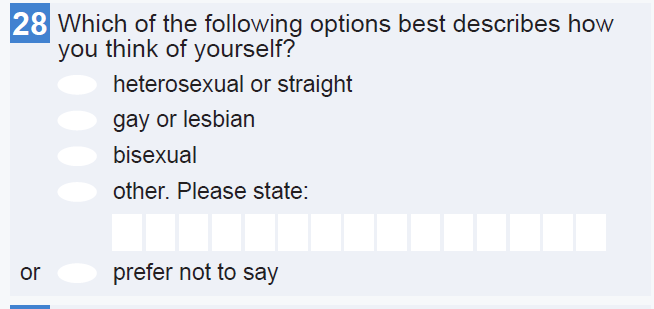
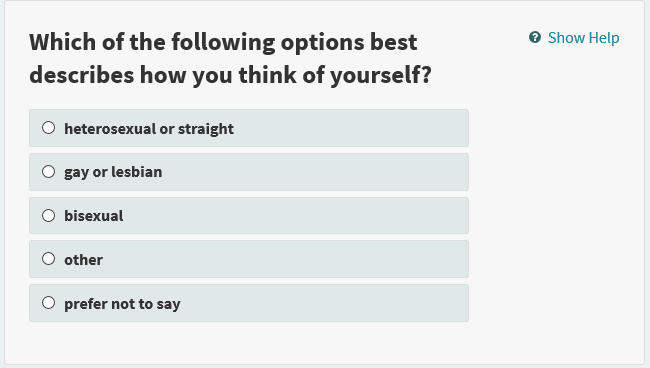
The question design tested in CPT was:
Online Form
SPRINT 7, COGNITIVE TESTING AND MASS COMPLETIONS OF PAPER FORMS
June/July 2016
Version 1 - Christchurch, Wellington
Version 2 - Napier
Aim:
Observe respondent attitudes to the presence of this question.
Observe any difference between “object to answer” as opposed to previously tested
“prefer not to say”.
Respondents The cognitive test participants included the general public, people with step family,
The mass completion test participants included: boarding school students, tertiary students, young
farmers, permanent residents at a holiday park, sports team, retirement village residents.
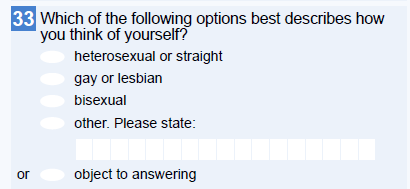
The question design tested in sprint 7 was:
SPRINT 7 – FINDINGS
Cognitive and group interview findings
There were no strong themes that emerged from the data for this question. Most
respondents answered the question with no difficulty and without comment. A few
respondents had some difficulty interpreting the response options and selecting their
response. One respondent sought clarification from the interviewer asking
“heterosexual/straight - that’s ‘normal’ isn’t it?” A couple of respondents noted the
‘object to answering’ category and commented that they would prefer a ‘prefer not to
say’ option, as they didn’t necessarily object to the question being asked in the form, but
they would personally prefer not to answer it.
Mass completion test findings
There were no significant issues from mass completion data.
SPRINT 7 – RECOMMENDATIONS
QMD recommends assessing data and respondent feedback from the Census Test (July
2016) for this question to further assess public sensitivity to the inclusion of this
question. The compliant respondent sample in this testing sprint combined with
interviewer presence may have masked any sensitivity toward this question which may
be expressed in other types of test environments.
QMD recommends that stakeholders consider the ‘prefer not to say’ versus the ‘object
to answering’ response categories and the explicit and implicit meaning that these
different response labels may convey to respondents. In addition QMD recommends
comparing Sprint 7 results which tested ‘object to answering’ with previous testing and
Census Test (July 2016) results to see if there are any observable effects introduced by
these two variations.
SPRINT 8, COGNITIVE TESTING AND MASS COMPLETIONS OF PAPER FORMS
July/August 2016
Wellington and Christchurch
Aims:
The Sexual Orientation variable had no specific testing objectives in this sprint.
Respondents
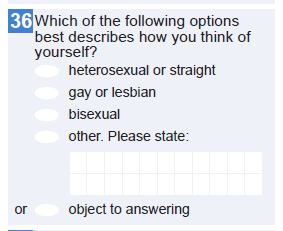

The cognitive test participants included renters, people with step family and parents with
children at home for proxy reporting. The mass completion test participants included
retirement village residents and members of the general public.
The question design tested in sprint 8 was:
SPRINT 9A, COGNITIVE TESTING AND MASS COMPLETIONS OF PAPER FORMS
July/August 2016
Wellington and Christchurch
Aims:
The Sexual Orientation variable had no specific testing objectives in this sprint.
Respondents The cognitive test participants included renters, people with step family and parents with
children at home for proxy reporting. The mass completion test participants included
retirement village residents and members of the general public.
The question design tested in sprint 9A was:
5 – Data quality
<Expectations based on testing, known issues, question interactions (suggested edits). To be
completed towards the end of QMD testing>
Appendix 1: testing methodology
Research objectives
The broad research objectives of testing may vary with each sprint, but generally are to:
Understand how well individual questions and key concepts/definitions are understood by
respondents
Understand how well individual questions and the overall form design enables respondents
to answer quickly and accurately
Understand how new and changed questions may impact on other questions in the forms
Understand respondent burden
Understand public attitudes to new and changed questions which may influence their
willingness to answer
Topics or questions may be allocated as a primary or secondary focus or not a focus of testing in a
given sprint. This depends on the priority of the variable itself and how well it has tested previously.
Desktop review (paper and online)
Questions and questionnaires (paper and/or online) are reviewed before they are tested with
respondents. The aim of desktop review is to:
Check whether the forms accurately match content and design specifications;
Identify any usability issues in the online forms (across a range of devices, operating systems
and browsers);
Identify any potential issues that should be subjected to further testing with the public.
Test participants
Testing aims to include people from a wide range of backgrounds, with a mix of age, sex, ethnicity,
income, employment status, etc. However an individual sprint may target respondents with
particular characteristics, for example, students, people who have children or stepfamily, Māori, or
tenure (renting, home owners, etc).
Test participants have been recruited using a variety of methods. These have included flyers posted
in public spaces such as libraries and YMCAs, Twitter and Facebook posts, contacting community
groups eg LGBQTI+, Step Family Network and the Retirement Village Association.
Testing methods
Three testing methods have been used, each with a different focus.
Cognitive testing
This is a qualitative, observational research method that helps identify problems with questionnaire
design. This methodology involves one-to-one interviews where respondents complete a
questionnaire. It uses techniques such as concurrent probing, retrospective probing and think-aloud
to highlight how respondents get to their answers and how they interpret certain terms.
Cognitive tests last around one hour, during which the first 30-40 minutes will involve the researcher
observing the respondent completing their dwelling form and individual form. The remaining 20-30
minutes will take a semi-structured interview approach. This time will be used to probe in-depth on
the focus questions described in this plan, which are relevant for respondents.
Mass completion + group interview
Mass completion tests involve asking a large group of respondents to complete a questionnaire
unobserved, in a supervised environment. Mass completion is a useful diagnostic tool to confirm
suspicions about a particular design or uncover unexpected reactions to questions using a larger
group of respondents.
Mass completion and group interview will last about one hour. In the first half of the session,
respondents will be asked to complete one or both Census forms. The remaining time will be used to
probe in-depth on the focus questions described in this plan, which are relevant for respondents.
The same semi-structured interview protocol can be used for cognitive testing and group interview.
Usability testing (online)
User testing involves one-to-one interviews where respondents complete a set of given tasks (e.g.
complete household set up page, complete Individual/Dwelling form) on a device ie a tablet,
smartphone or desktop. It is a qualitative, observational research method used to identify problems
with a user interface. User testing employs think-aloud, concurrent probing, and retrospective
probing techniques to understand how the design of the user interface impacts on the user
experience.
Analysis
From sprint 7 onwards, findings were coded to approximately 20 codes, which were further
summarised into themes:
Table: Analysis of testing findings – codes and themes used
Codes
Themes
Theme Description
Total nonresponse due to
Relates to how and why respondents
sensitivity
Sensitivity
perceive question content to be sensitive
Protest response
to themselves and other people.
Sensitivity is often based on the individual
Selection of ‘object to answer’
person’s personal experiences, worldview
response
and personal values and can affect their
Reluctant response
willingness to respond.
Sensitivity on behalf of others
Relates to the explicit or implicit value
Questioning why we ask
Value / Value +
judgements that respondents make about
a question and whether they perceive it
Questioning use of data
as having value, or not. Whether
Willingness to answer based on
respondents perceive a question to have
value judgement
value or not will affect both their
willingness to answer and the quality of
their response should they choose to
Positive comment volunteered
answer.
regarding info need
Difficulty in recalling the
Burden
Relates to the ease with which
requested information
respondents are able to answer questions
Difficulty in interpreting the
and the extent to which they have a
question
positive respondent experience. There
Difficulty in fitting their answer
are many aspects of respondent burden
into the response formats/
which respondents may experience when
categories
answering questions. Some of these arise
from ambiguous or unfamiliar terms or
Confusion or difficulties arising
concepts in the questionnaire, while
from interactions between
others may be a direct effect of the
questions
poorly designed question or form.
Effort required to answer
Missed routing instructions
Error
Relates to causes of respondent error
Instructions missed or incorrectly
that can affect data quality and reliability.
followed
Sources of error usually arise from poor
question and form design, but may also
Subjective response
include contextual factors specific to the
Proxy response error
respondent which can’t be controlled for.
Guesses
Poor question construction
Relates to respondent burden and error,
Dissatisfaction with
specifically arising from poor question
question/response options
Defective design and form design. A fundamentally
defective question or set of questions
may negatively impact on data quality
Visual design of form
and/or the user experience.
Testing collects information about people’s willingness and ability to answer. Not all of these
findings will result in alterations to the questionnaire, and any changes that are made may not
necessarily resolve the issues found.







